Australian Wound Management Association Standards for Wound Management
Added on 2023-06-03
36 Pages11071 Words417 Views
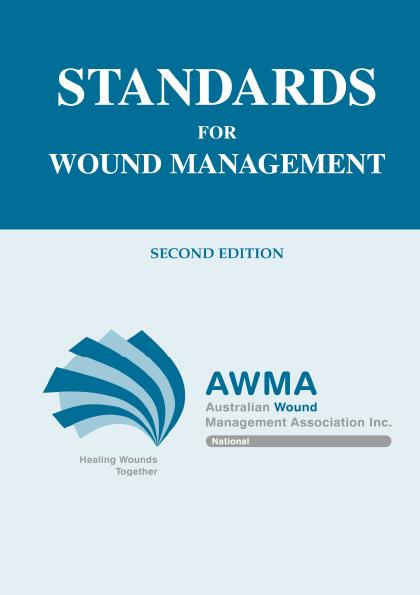
Australian Wound Management
Association Inc.
Philosophy
The Australian Wound
Management Association Inc.
believe that all people with,
or who are likely to develop a
wound, are entitled to receive
personalised care and management
that is supported by current
validated research.
Standards for Wound Management
2nd edition, March 2010
Published by the Australian Wound Management Association Inc
ISBN 978-0-9807842-1-3
Copyright © The Australian Wound Management Association Inc, 2010
All rights reserved
Association Inc.
Philosophy
The Australian Wound
Management Association Inc.
believe that all people with,
or who are likely to develop a
wound, are entitled to receive
personalised care and management
that is supported by current
validated research.
Standards for Wound Management
2nd edition, March 2010
Published by the Australian Wound Management Association Inc
ISBN 978-0-9807842-1-3
Copyright © The Australian Wound Management Association Inc, 2010
All rights reserved
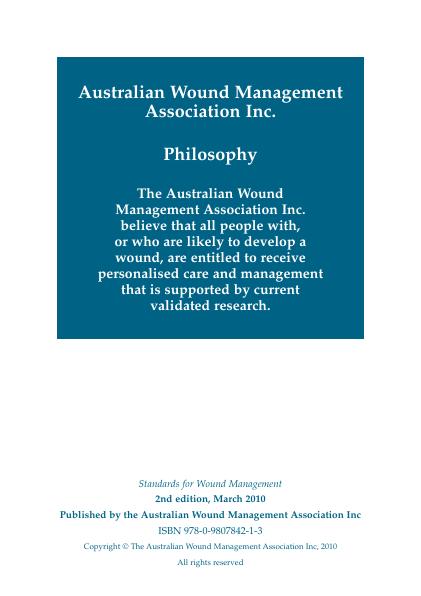
Australian Wound Management Association
PREFACE
The Australian Wound Management Association Inc. (AWMA) is a multidisciplinary
professional association for persons with an interest in wound healing and wound
management. The objectives of the AWMA are to raise awareness of the science and art of
wound healing and promote scientifically substantiated wound management practices.
The Standards for Wound Management presented in this revised second edition provide
a framework for promoting best practice in wound management as they reflect current
evidence. The Standards will be a valuable tool for directing clinical practice and the
development of policies, protocols and education programs. The aim of the Standards is to
facilitate quality care outcomes for persons with wounds or potential wounds.
It is the ongoing vision of the AWMA that these Standards will be adopted by health
professionals and service providers across Australia and that the challenge associated
with validating and embedding the Standards across all practice settings be taken up
enthusiastically.
ACKNOWLEDGEMENT
The second edition of the AWMA Standards for Wound Management have been revised
by the Standards Subcommittee in consultation with the Association. An expression of
appreciation is extended to the Standards Subcommittee:
Keryln Carville RN, STN(Cred), PhD, MRCNA (Chairperson)
Juliet Scott RN, B App Sc (Prim Hlth), Grad Cert, Grad Dip DN, MN (NP), (Secretary)
Sue Templeton RN, BN, MNSc(NP)
Terry Swanson RN, NPWM, Grad Cert (Peri-op), M. Hlth, Sc(Nsg), MRCNA, FMACNP
Pam Morey RN, BN, STN, MN, NP, MRCNA
Laurence Foley Dip Ch. Grad Dip (Hlth Sci) MSc F.A.Pod.A.
Dianne Smith M.B, B.S, Grad Dip Family Medicine
Margo Asimus RN, WMNP, RM, STN
Jennifer Byrnes RN, WMNP, STN
Associate Professor Michael Woodward MB, BS, FRACP
President, Australian Wound Management Association
PREFACE
The Australian Wound Management Association Inc. (AWMA) is a multidisciplinary
professional association for persons with an interest in wound healing and wound
management. The objectives of the AWMA are to raise awareness of the science and art of
wound healing and promote scientifically substantiated wound management practices.
The Standards for Wound Management presented in this revised second edition provide
a framework for promoting best practice in wound management as they reflect current
evidence. The Standards will be a valuable tool for directing clinical practice and the
development of policies, protocols and education programs. The aim of the Standards is to
facilitate quality care outcomes for persons with wounds or potential wounds.
It is the ongoing vision of the AWMA that these Standards will be adopted by health
professionals and service providers across Australia and that the challenge associated
with validating and embedding the Standards across all practice settings be taken up
enthusiastically.
ACKNOWLEDGEMENT
The second edition of the AWMA Standards for Wound Management have been revised
by the Standards Subcommittee in consultation with the Association. An expression of
appreciation is extended to the Standards Subcommittee:
Keryln Carville RN, STN(Cred), PhD, MRCNA (Chairperson)
Juliet Scott RN, B App Sc (Prim Hlth), Grad Cert, Grad Dip DN, MN (NP), (Secretary)
Sue Templeton RN, BN, MNSc(NP)
Terry Swanson RN, NPWM, Grad Cert (Peri-op), M. Hlth, Sc(Nsg), MRCNA, FMACNP
Pam Morey RN, BN, STN, MN, NP, MRCNA
Laurence Foley Dip Ch. Grad Dip (Hlth Sci) MSc F.A.Pod.A.
Dianne Smith M.B, B.S, Grad Dip Family Medicine
Margo Asimus RN, WMNP, RM, STN
Jennifer Byrnes RN, WMNP, STN
Associate Professor Michael Woodward MB, BS, FRACP
President, Australian Wound Management Association

CONTENTS
INTRODUCTION 1
STANDARD 1
COLLABORATIVE PRACTICE AND INTERPROFESSIONAL CARE 2
STANDARD 2
PROFESSIONAL PRACTICE 4
STANDARD 3
CLINICAL DECISION MAKING: ASSESSMENT AND PLANNING 6
STANDARD 4
CLINICAL DECISION MAKING: PRACTICE 13
STANDARD 5
DOCUMENTATION 19
STANDARD 6
EDUCATION 21
STANDARD 7
RESEARCH 23
STANDARD 8
CORPORATE GOVERNANCE 24
GLOSSARY 25
REFERENCES 26
Standards for wound management
INTRODUCTION 1
STANDARD 1
COLLABORATIVE PRACTICE AND INTERPROFESSIONAL CARE 2
STANDARD 2
PROFESSIONAL PRACTICE 4
STANDARD 3
CLINICAL DECISION MAKING: ASSESSMENT AND PLANNING 6
STANDARD 4
CLINICAL DECISION MAKING: PRACTICE 13
STANDARD 5
DOCUMENTATION 19
STANDARD 6
EDUCATION 21
STANDARD 7
RESEARCH 23
STANDARD 8
CORPORATE GOVERNANCE 24
GLOSSARY 25
REFERENCES 26
Standards for wound management
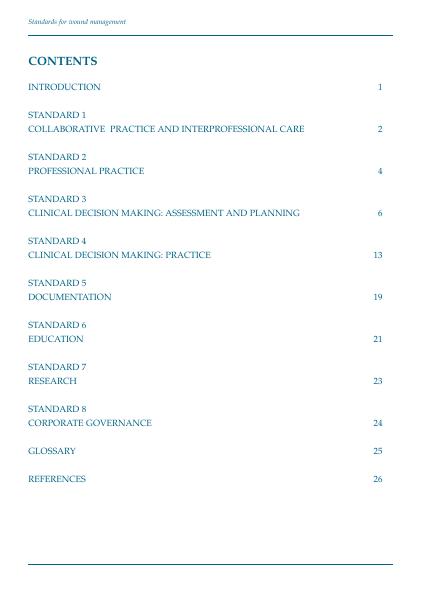
Australian Wound Management Association
page 1
INTRODUCTION
The Australian Wound Management Association Inc. Standards for Wound Management
are intended to be reflective of best practice as defined in the literature and in the consensus
opinions sought from expert wound clinicians. The Standards are presented as a guide
to clinicians, educators and researchers, health students and health care providers who
desire to promote optimal outcomes in the care of individuals with wounds or those at
risk of wounding. The Standards are intended to be broad, which allows for their flexible
application in accord with the needs of individual disciplines and practice settings.
The performance criteria listed in the Standards are considered to be base criteria for
achieving each Standard. However, individual health professionals and health care
providers are at liberty to adapt the criteria in context for achieving each Standard according
to the expectations of individual professional roles, practice settings, legislation governing
practice and institutional requirements for determining a standard of care.
The second edition of the Standards contains an additional Standard 8: Corporate
Governance. It is recognised that the onus of responsibility for provision of best practice in
wound management is shared by all involved health care providers.
Wound healing and the development of standards of care are both dynamic processes. It
is anticipated that reviews of these Standards will occur as scientific endeavours promote
greater understanding of the phenomenon of wound healing and best practice management.
The Australian Wound Management Association welcomes comments and feedback at any
time.
The Standards do not promote or endorse specific products, devices, pharmaceuticals or
therapies.
page 1
INTRODUCTION
The Australian Wound Management Association Inc. Standards for Wound Management
are intended to be reflective of best practice as defined in the literature and in the consensus
opinions sought from expert wound clinicians. The Standards are presented as a guide
to clinicians, educators and researchers, health students and health care providers who
desire to promote optimal outcomes in the care of individuals with wounds or those at
risk of wounding. The Standards are intended to be broad, which allows for their flexible
application in accord with the needs of individual disciplines and practice settings.
The performance criteria listed in the Standards are considered to be base criteria for
achieving each Standard. However, individual health professionals and health care
providers are at liberty to adapt the criteria in context for achieving each Standard according
to the expectations of individual professional roles, practice settings, legislation governing
practice and institutional requirements for determining a standard of care.
The second edition of the Standards contains an additional Standard 8: Corporate
Governance. It is recognised that the onus of responsibility for provision of best practice in
wound management is shared by all involved health care providers.
Wound healing and the development of standards of care are both dynamic processes. It
is anticipated that reviews of these Standards will occur as scientific endeavours promote
greater understanding of the phenomenon of wound healing and best practice management.
The Australian Wound Management Association welcomes comments and feedback at any
time.
The Standards do not promote or endorse specific products, devices, pharmaceuticals or
therapies.
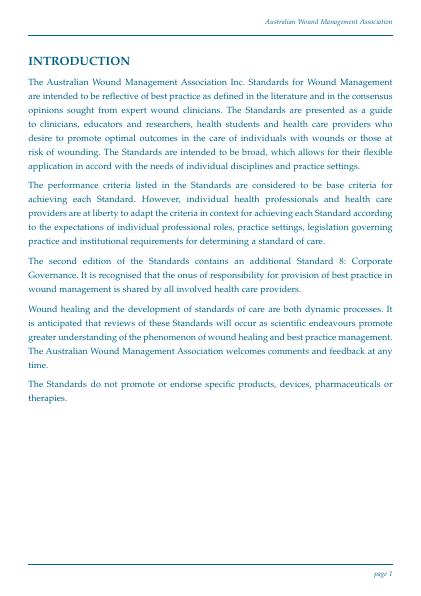
page 2
Standards for wound management
STANDARD 1
COLLABORATIVE PRACTICE AND INTERPROFESSIONAL CARE
The optimal healing of the individual with a wound, or potential wound is
promoted by a collaborative and interprofessional approach to wound management.
Collaborative practice includes evidence that the clinician:
1.1 Acknowledges the central role of the individual and their carer in wound
management and relevant health care decisions1-4.
Performance Criteria
The clinician will ensure the individual and their carer will be informed of:
1.1.1 The need and options for comprehensive and interprofessional team assessment.
1.1.2 Assessment outcomes.
1.1.3 Opportunities and information to encourage and facilitate their participation in
wound management and wound prevention.
1.2 Establishes and maintains communication that facilitates interprofessional
collaboration and coordination of care3,5-10.
Performance Criteria
The clinician will:
1.2.1 Liaise and maintain regular communication with the interprofessional team.
1.2.2 Initiate timely and additional communication when there are changes that
impact on the individual, their wound and their wound healing environment.
Standards for wound management
STANDARD 1
COLLABORATIVE PRACTICE AND INTERPROFESSIONAL CARE
The optimal healing of the individual with a wound, or potential wound is
promoted by a collaborative and interprofessional approach to wound management.
Collaborative practice includes evidence that the clinician:
1.1 Acknowledges the central role of the individual and their carer in wound
management and relevant health care decisions1-4.
Performance Criteria
The clinician will ensure the individual and their carer will be informed of:
1.1.1 The need and options for comprehensive and interprofessional team assessment.
1.1.2 Assessment outcomes.
1.1.3 Opportunities and information to encourage and facilitate their participation in
wound management and wound prevention.
1.2 Establishes and maintains communication that facilitates interprofessional
collaboration and coordination of care3,5-10.
Performance Criteria
The clinician will:
1.2.1 Liaise and maintain regular communication with the interprofessional team.
1.2.2 Initiate timely and additional communication when there are changes that
impact on the individual, their wound and their wound healing environment.
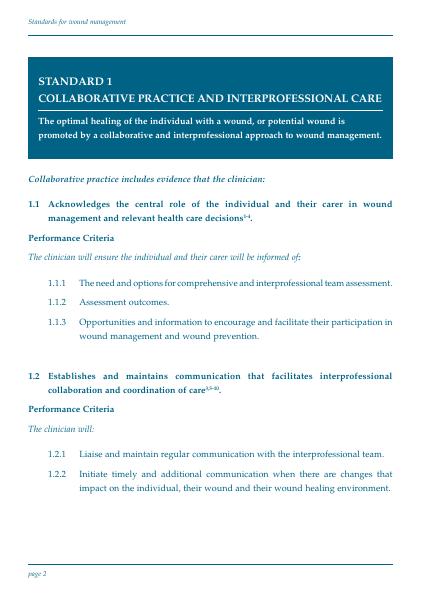
Australian Wound Management Association
page 3
1.3 Recognises the knowledge, skills and contributions provided by members of the
interprofessional team11-14.
Performance Criteria
The clinician will:
1.3.1 Utilise a collaborative and interprofessional approach in wound management
and wound prevention.
1.3.2 Refer to other members of the interprofessional team when wound management
requirements are outside their scope of practice.
1.3.3 Advocate for collaborative and interprofessional services where they currently
do not exist.
page 3
1.3 Recognises the knowledge, skills and contributions provided by members of the
interprofessional team11-14.
Performance Criteria
The clinician will:
1.3.1 Utilise a collaborative and interprofessional approach in wound management
and wound prevention.
1.3.2 Refer to other members of the interprofessional team when wound management
requirements are outside their scope of practice.
1.3.3 Advocate for collaborative and interprofessional services where they currently
do not exist.
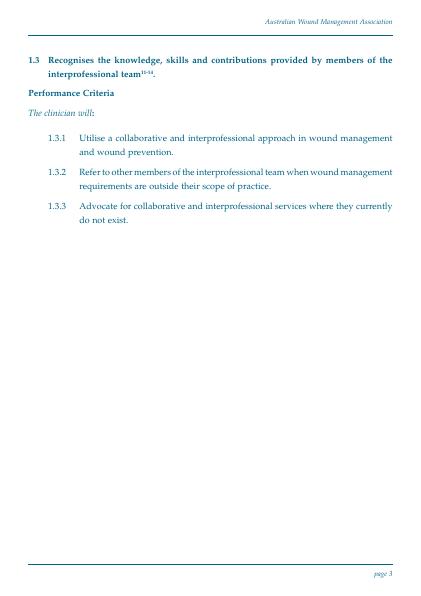
page 4
Standards for wound management
The obligations of the professional role are demonstrated by:
2.1 Performance in accordance with legislation and regulations affecting professional
responsibilities and code of practice14, 15-21.
Performance Criteria
The clinician will:
2.1.1 Function in accordance with the professional code of practice as determined by
their regulatory authority.
2.1.2 Be accountable for and function within their scope of practice.
2.1.3 Be aware of limitations of scope of practice for regulated and non-regulated
practice.
2. 2 Application of evidence based wound management and prevention and advocacy
when deficits exist22-30.
Performance Criteria
The clinician will:
2.2.1 Seek access to evidence from reputable sources.
2.2.2 Utilise best available evidence to direct practice.
2.2.3 Advocate for and promote evidence based practice amongst the interprofessional
team.
STANDARD 2
PROFESSIONAL PRACTICE
The safety and wound healing potential of the individual is ensured by clinical
practice that respects and complies with legislation, regulations, codes of practice,
evidence and health provider policies.
Standards for wound management
The obligations of the professional role are demonstrated by:
2.1 Performance in accordance with legislation and regulations affecting professional
responsibilities and code of practice14, 15-21.
Performance Criteria
The clinician will:
2.1.1 Function in accordance with the professional code of practice as determined by
their regulatory authority.
2.1.2 Be accountable for and function within their scope of practice.
2.1.3 Be aware of limitations of scope of practice for regulated and non-regulated
practice.
2. 2 Application of evidence based wound management and prevention and advocacy
when deficits exist22-30.
Performance Criteria
The clinician will:
2.2.1 Seek access to evidence from reputable sources.
2.2.2 Utilise best available evidence to direct practice.
2.2.3 Advocate for and promote evidence based practice amongst the interprofessional
team.
STANDARD 2
PROFESSIONAL PRACTICE
The safety and wound healing potential of the individual is ensured by clinical
practice that respects and complies with legislation, regulations, codes of practice,
evidence and health provider policies.
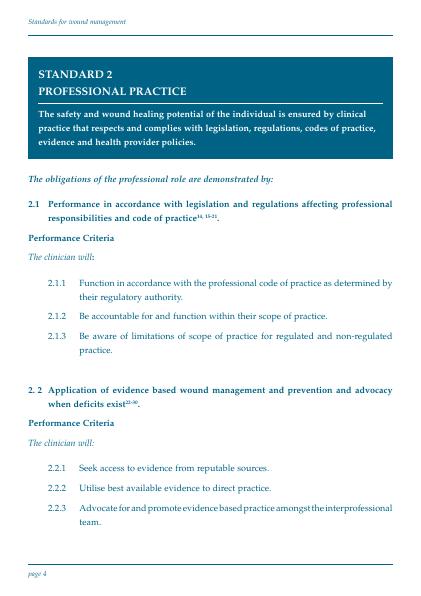
End of preview
Want to access all the pages? Upload your documents or become a member.
